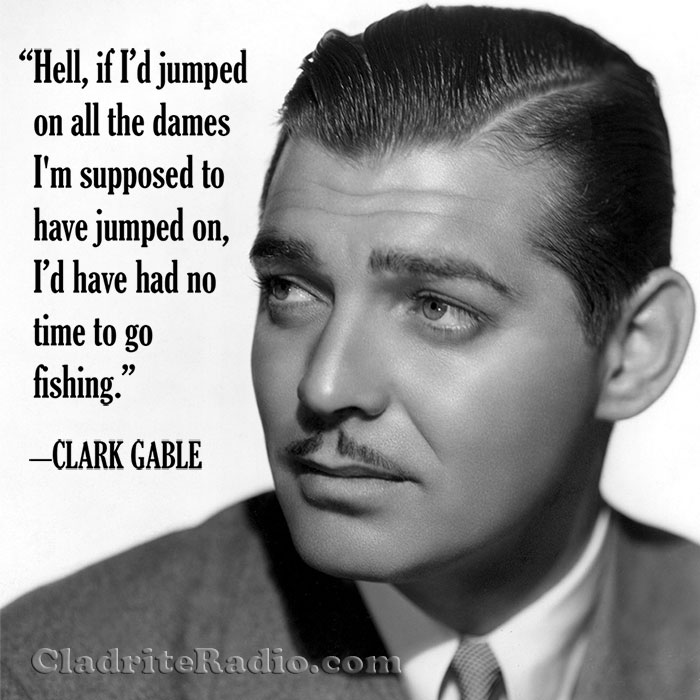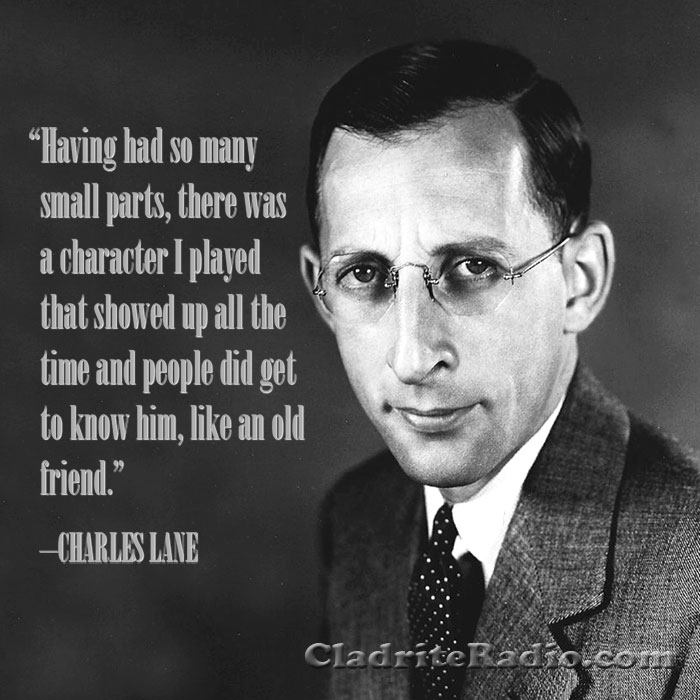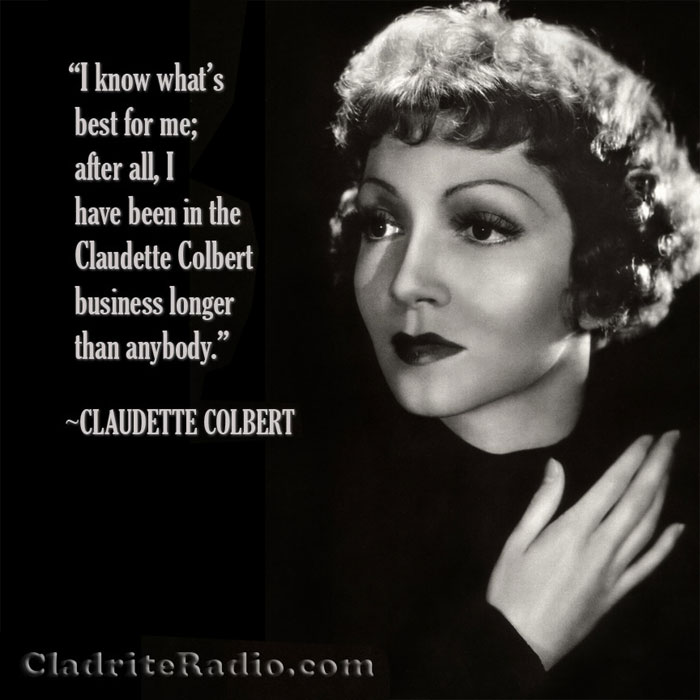Here are 10 things you should know about Murray Alper, born 117 years ago today. The prolific character actor amassed 250 credits over the course of a 40-year film and TV career.
Tag: Frank Capra
Happy 116th Birthday, Clark Gable!
Clark Gable was born William Clark Gable 116 years ago today in Cadiz, Ohio. In his day, he was known as the King of Hollywood or, often, just as the King. Here are 10 CG Did-You-Knows:
- Gable was named after his father, William, who was an oil well driller, but even as a child, he was referred to by his middle name or sometimes as Billy. His birth certificate mistakenly listed Gable as female.
- Gable’s stepmother (his birth mother died when he was young) encouraged his interest in music, teaching him to play piano. He later took up brass instruments and at age 13, he was the only teen to play in the men’s town band. Gable’s father encouraged him from an early age to be well-dressed and well-groomed.
- At 17, Gable decided he decided to pursue a career in the theatre and by 21, he was touring in stock companies, along with jobs in the oil fields and working with horses. Josephine Dillon, an acting coach and theatrical manager in Portland, Oregon, set out to remake Gable from head to toe. She paid for him to get new teeth, she built up his once-slight physique with a proper diet and strenuous exercise and helped him improve his movements and posture. She also worked at length to lower his high-pitched voice and improve his diction.
- Dillon, who was 17 years Gable’s senior, also financed Gable’s relocation from Portland to Hollywood in 1924, where she officially became his manager and his wife. He changed his professional name from W. C. Gable to Clark Gable and began to work as an extra and a bit player in silent short and features.
- When no leading film roles were in the offing, Gable returned to the stage, acting for a season with the Laskin Brothers Stock Company in Houston, Texas, where he played a variety of roles and gained valuable experience. Finally, with the ascent of talking pictures, Gable’s stock as an actor rose as well. He was offered a contract with MGM in 1930. His first role was as a rough-hewn villain in a William Boyd western, The Painted Desert (1930). His imposing stature and now-powerful speaking voice made a quick hit with moviegoers (especially female ones).
- Many of Gable’s early roles were tough guys, gangsters and villains, and though no less an authority than Darryl F. Zanuck had once said of Gable, “His ears are too big and he looks like an ape,” he was finding himself cast opposite popular leading ladies of the day, including Joan Crawford, Barbara Stanwyck, Norma Shearer and even Greta Garbo (with whom he shared a mutual dislike—she thought his acting wooden; he thought her a snob).
- Despite long being known as the King of Hollywood, Gable was never No 1 at the box office in a given year, but year after year, he ranked near the top, as the fortunes of other actors rose and fell. His breakthrough role was his Oscar-winning performance in Frank Capra‘s It Happened One Night in 1934, opposite Claudette Colbert. That classic film won the Best Picture Oscar to go along with Gable’s Best Actor nod. Capra considered the role of Peter Warne in the film the closest to Gable’s actual personality: “It Happened One Night is the real Gable,” he wrote. “He was never able to play that kind of character except in that one film. They had him playing these big, huff-and-puff he-man lovers, but he was not that kind of guy. He was a down-to-earth guy, he loved everything, he got down with the common people. He didn’t want to play those big lover parts; he just wanted to play Clark Gable, the way he was in It Happened One Night, and it’s too bad they didn’t let him keep up with that.”
- Gable is said to have been Adolph Hitler‘s favorite actor, and it’s been reported that Hitler offered a reward to anyone who could capture Gable, then flying combat missions over Germany, and bring him to Hitler unharmed. The reward went unclaimed.
- Gable played a newspaper reporter in nine different pictures, more than any other type of role, but late in life, he expressed regret that he hadn’t appeared in more westerns, the genre he most enjoyed working in.
- Gable was married five times, the first two times to women many years his senior, but it is generally accepted that his third Wife, actress Carole Lombard, was the great love of his life. She even got Gable, a lifelong Republican, to support Franklin Delano Roosevelt for president. It’s said that Lombard’s tragic death in a plane crash in 1942 left Gable so bereft that he immediately enlisted in the Army Air Corps and was absent from the silver screen for three years.
Happy birthday, Clark Gable, wherever you may be!

Happy 112th Birthday, Charles Lane!
We don’t have so many regrets, really, and certainly nothing major. But we continue to kick ourselves for not writing a fan letter to (or perhaps even trying to arrange an interview with) character actor extraordinaire Charles Lane, born Charles Gerstle Levison 112 years ago today in San Francisco, California, before he passed on in 2007.
Think of it: Here was a man who started acting in pictures in 1930 at the age of 25 and was still with us a mere decade ago. And all reports have it that he was still very sharp at age 102. Think of the stories he had to tell!
Here are 10 CL Did-You-Knows:
- Lane’s first career was in insurance sales, but director Irving Pichel recommended he take up acting and he did, working in stage productions at the famed Pasadena Playhouse.
- Lane’s movie debut was a brief appearance in Smart Money (1931) as a hotel desk clerk. His first credited role, as Charles Levinson, was as a switchboard operator in Looking for Trouble (1934). It was his 22nd movie.
- Between 1930 and 1952, Lane had appeared in more than 200 features, generally playing characters who were at the very least officious, if not downright sourpusses. This typecasting was frustrating to Lane, who continued to work in live theatre throughout his career to counteract his cinematic pigeonholing. “You did something that was pretty good, and the picture was pretty good,” he would later say. “That pedigreed you in that type of part, which I thought was stupid, and unfair, too. It didn’t give me a chance, but it made casting easier for the studio.”
- Lane’s movie appearances were generally brief but usually memorable, and he appeared in more than his share of pictures that are today considered classics, among them 42nd Street (1933), Twentieth Century (1934), Mr. Deeds Goes to Town (1936), Mr. Smith Goes to Washington (1939), I Wake Up Screaming (1941), Arsenic and Old Lace (1944) and It’s a Wonderful Life (1946), among others.
- Lane was a charter member of the Screen Actors Guild. “[The studios] work you until midnight and get you back at seven in the morning,” he said. “The actors were taking a terrible licking physically. Generally, as the case with any union, you form it because people are abused.” The Guild named January 30th, 2005, as Charles Lane Day.
- Lane was friends with Lucille Ball going back to her days as a Hollywood starlet, and when she became a huge success on television, she cast him frequently on her sitcoms.
- Lane appeared in 10 films helmed by Frank Capra, and in a letter the director once sent to Lane, Capra wrote, “I am sure that everyone has someone that he can lean on and use as a crutch whenever stories and scenes threaten to fall apart. Well, Charlie, you’ve been my No. 1 crutch.”
- Born in San Francisco in 1905, Lane was one of the last survivors of that city’s 1906 earthquake.
- Lane was a strong horseman and regretted that in all the pictures he appeared in, he never got to ride a horse. He claimed that he had, in fact, trained some of the western actors in horseback riding.
- Beginning with a 1951 appearance on The George Burns and Gracie Allen Show, Lane was as familiar a face on television as he was on the silver screen, appearing on many dozens of programs over the next four-plus decades. Lane would play a client for McMahon and Tate on Bewitched no fewer than 8 times.
Happy birthday, Charles Lane, wherever you may be!

Happy 116th Birthday, Jean Arthur!
The wonderful Jean Arthur was born Gladys Georgianna Greene 116 years ago today in Plattsburgh, New York. She was a reluctant and, some say, unlikely star, but she was one of the true greats in the genre of screwball and romantic comedies. Here are 10 JA Did-You-Knows:
- Arthur was of Norwegian and English descent. Her father was a photographer, and her family relocated frequently as she was growing up; she would spend time in Jacksonville, Florida; Schenectady, New York; Saranac Lake, New York; and Manhattan’s Washington Heights neighborhood (the building she lived is still there, at 573 West 159th Street).
- In the early 1920s, Arthur worked as stenographer. She also did some commercial modeling, and it was via her modeling work that she was discovered by Fox Film Studios, who thought she could be remade into a “flapper” type. She made her debut in Cameo Kirby (1923), directed by John Ford.
- It’s said that she took her stage name from two of her heroes: Joan of Arc and King Arthur (we are skeptical of this, to be honest, but we are merely reporting what’s long been claimed).
- Arthur’s trademarks as an actress were her comic timing and her distinctive voice, which Frank Capra described in his autobiography as “low, husky—at times it broke pleasingly into the high octaves like a thousand tinkling bells.”
- Arthur was named one of the WAMPAS Baby Stars of 1929, along with Anita Page, Helen Twelvetrees and Loretta Young, among others.
- Her film career floundering in the early 1930s, Arthur returned to New York City to hone her acting chops in a series of Broadway productions. Having gained confidence in her abilities, she returned to Hollywood in 1934, signing a five-year contract with Columbia Pictures that brought her financial stability. She also went blonde and would remain so throughout her career.
- Arthur was convinced her left side was her best side, and she insisted on being filmed from that side whenever possible.
- Arthur made three pictures with director Frank Capra, all of them very successful: Mr. Deeds Goes to Town (1936), You Can’t Take It with You (1938) and Mr. Smith Goes to Washington (1939). Capra once named her as his favorite actress.
- The borderline reclusive Arthur was reluctant to participate in publicity efforts for her pictures. she was not active in the Hollywood social whirl and was hesitant to give interviews.
- Arthur received one Academy Award nomination, in the Best Actress in a Leading Role category for The More the Merrier (1943). A year earlier, she won the Sour Apple Award from the Hollywood Women’s Press Club, which was given to the year’s “Least Cooperative Actor/Actress.”
Happy birthday, Jean Arthur, wherever you may be!

Happy 113th Birthday, Claudette Colbert!
The lovely Claudette Colbert was born Emilie Claudette Chauchoin 113 years agao today in Saint-Mandé, France, an eastern suburb of Paris. We saw her perform on Broadway 31 years ago opposite Rex Harrison in a drawing room comedy called Aren’t We All? and it remains among our greatest regrets that we didn’t play Stage-Door Johnny after the show to tell her how we admired her. Here are 10 CC Did-You-Knows:
- Her father owned a bakery on what is now Avenue Général de Gaulle, but the family moved to New York City in 1906.
- Colbert attended Washington Irving High School in New York City, graduating in 1923.
- As a child, Colbert dreamed of being a Broadway actress, and to that end, after her formal education was completed, she enrolled for dramatic training at the Art Students League of New York and paid for her studies by working in a dress shop.
- She debuted on Broadway in 1923 in a play called The Wild Wescotts, and it was during that show’s run that she changed her name.
- She turned to films as a practical choice when the Great Depression proved to be a difficult time for live theatre. Her first movie was a 1927 Frank Capra-directed silent picture called For the Love of Mike (alas, the film is now considered lost). It was so poorly under-budgeted that Capra had to hitchhike back to Hollywood from New York City. After making the picture, Colbert vowed, “I shall never make another film.”
- Colbert considered her left side to be her best and was rarely photographed from any other angle.
- Colbert was so convinced that she wouldn’t win the Oscar for It Happened One Night (1934) that she skipped the ceremony. She was quickly transported over from a train station when the announcement was made that she had won.
- Colbert turned down the role of Hildy Johnson in His Girl Friday (1940).
- Colbert was one of five French actresses (though she later became a naturalized U.S. citizen) to win an Academy Award and one of just 12 French actresses to earn an Oscar nomination.
- Her nickname was Lily.
Happy birthday, Claudette Colbert, wherever you may be!

